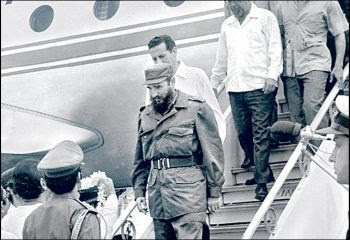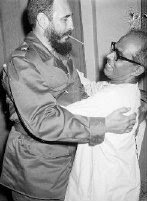
The global slowdown will further hit India’s economy and the worst sufferers will be its burgeoning underprivileged, Nobel Laureate Amartya Sen tells TUSHA MITTAL
What are the principal challenges India faces in the new year?
There are traditional challenges and new ones. The traditional challenges include keeping our democracy functioning. The [general] election is coming; it is very important that there be wide participation. It is also important that our concerns about secularism, security, economic progress, and the removal of poverty and illiteracy be kept in focus. Election is a good time to focus on these issues rather than one caste battling another.
Another old challenge is removing deprivation. Huge numbers of people suffer from chronic hunger, malnutrition, lack of schooling and healthcare. Political parties should focus more on these issues. When I gave a lecture in Parliament last August, I mentioned that I am sometimes disappointed that the pressure on the government comes more on issues that concern a few people, like the Indo- US nuclear deal or rise in petrol prices, and the huge deprivation of the underprivileged masses tends to get neglected.
The global economic crisis is another new challenge: it has not yet affected India as much as it might in 2009. I will expect the growth rate, which has already fallen from nine percent to seven percent, may decline to five or six percent. Although five-to-six percent growth is not bad progress, the important thing is that underprivileged Indians will suffer greatly from that slowdown.
You’ve said that over-reliance on markets contributed to the meltdown. Has this prompted rethink on the idea of free market?
In India’s case this is more complicated. Over-reliance is in the context of the US. There, the supervisory role of the state was pretty much abandoned. Irresponsible financial actions like sub-prime mortgage lending were not regulated. There was no regulation on derivative markets either, so some of these terrible toxic loans and assets were immediately sold to others. So you can’t even find out who did how much wrong to whom.In our case, if anything, there has been under-reliance on markets in some areas. This is true for many industries and for the service sectors: tourism, for example. I still haven’t stayed in a comfortable government hotel. Someday, I hope I will. But the disastrous thing on the other side has been premature privatisation of the healthcare and education system. This is complicated by bad delivery of primary school education and healthcare by the state. That means richer kids go to private schools or private healthcare, and there is no pressure on the government coming from powerful quarters. We have to make sure the public sector rises to the challenge so that the private sector does not have this role to play.The reliance on the private sector for elementary education is very unfortunate, but we can’t just say the private sector is the evil. It is part of the problem, but the bigger problem is the public sector’s deficiency which makes the private sector flourish. That needs to change. If you look at any country in Europe, or the US, Canada, Japan, South Korea, all these countries have become literate on the basis of state-provided primary education for all. And with the exception of the US, they have provided basic universal healthcare through the state system to all.
What will it take to make this a reality, since most policies now seem skewed in favour of corporate India?
That’s true. Because corporate India absorbs a lot of interest and people, things seem ill-balanced. Elections and media criticism give the public an opportunity to raise these issues. But, we need not only periodic raising of important issues every five years, we have to constantly question the terrible delivery of basic education and healthcare. If we agitate for better healthcare and more governmental concern, we will get the responsible politics we deserve. We have to make it clear that politicians recognise there is something at stake for them in terms of their performance.
Many believe the benefits of capitalism and globalisation haven’t trickled down. Yet, there is a view that access to global markets, international trade, and investment will bring jobs, which will gradually remove poverty. Is there a danger in this assumption?
This in itself is not enough to get India out of poverty, but it is a useful thing and it is important. No one policy is going to be enough, and there is never much point in asking which one — exactly one — should be done. We have to do not one thing but ten different things. And making use of the global market is certainly a very important part of the balance basket. I think making good policy decisions on that is important. We should think about a future in which the market and the state both have a role to play.
What is your opinion of the concept of special economic zones (SEZ)?
I have by and large been opposed to SEZs. It is important when incomes are growing for public revenue to flow in, and when you do SEZs, no public revenue flows in because you give them tax exemption. I also think SEZs can breed corruption. The oddity is that the argument for doing these things is the market economy. But then why do you do an SEZ, which is really state-based favouritism. I think we should make better use of the market and the global economy, bearing in mind that it needs to be supplemented by well organised public services.
You’ve said more funds should be spent on education, healthcare and tackling poverty. Yet, most government programmes which appear to have social relevance (NREGS, the farmer debt relief package) seem to backfire. What needs to happen to have tangible results on the ground?
I don’t think that there are no tangible results. If you look at the NREGS scheme, there are a huge number of problems but there have also been successes. Lots of needy people have got jobs and made good use of their income. Intensive child development schemes have been successful in states like Tamil Nadu, but not in many others. We have to see why it is so mixed. The lack of funding is certainly a problem and is the most important issue to be addressed. But the delivery system has to be improved and I think it is very important to expand the organisational network. The Pratichi Trust, which I was fortunate to be able to set up when the Nobel Prize came my way in 1998, has been particularly concerned with the delivery of primary education and healthcare. We found big neglects there. It was our analysis that the unions could make a difference by helping to make their workers on the ground, teachers and doctors in this case, more accountable and responsible. We have been working with the primary teachers’ association in West Bengal (ABPTA), the largest of the primary school unions. Our recent research findings show an increase in attendance. For example, in my district Birbhum in West Bengal, attendance has gone up from about 50 percent to 80 percent. There has been a similar increase in other districts.I think we need a change in the organisational presumptions in India. The public sector is terrible in some fields, like agriculture. But in others, like the railways, the public sector has a huge amount to offer, and performances have been exceptionally good. In healthcare, education and child integrated development, there is a real problem to be addressed. I think we need much more cooperation with the unions, and that requires rethinking, both on the part of the union, not just to think of the interest of their membership but also of the community and the country, but also on the other side. Many people are so suspicious of unions, they don’t think anything good can ever come out of them. We have to trust the unions more and they have to work in a way that they make themselves trustworthy.
You are known to be closely aligned with the Left. Is the party living up to the ideals it claims to represent?
The Left parties should have been more focused on deprivation, illiteracy and lack of healthcare, rather than the Indo-US nuclear deal, and against public sector reform. I think the basic issues of poverty should receive much more attention. I belong to the Left. I would like them to be more concerned with the poorest sections of the community and avoid divisions that make the voice of the underdog weak.
You mentioned concerns about secularism. What is your assessment of the success of secularism in India?
I think secularism in India is a success, but it requires constant vigilance. It is often said that the price of liberty is eternal vigilance; the price of functioning secularism is also constant vigilance. I don’t think secularism in India has failed because we haven’t had major communal violence since the dark days of Gujarat 2002. Even the identification of terrorists in Mumbai as Islamist terrorists has not led to the intensification or the germination of Hindu- Muslim hostility. I think that is a tribute to Indian secularism. The weakness of Indian secularism can be seen in the targeting of Christians in Orissa, and even though it hasn’t reached the level of barbarity that we saw in 2002, it requires immediate vigilance and eradication. Not only because it can escalate into bigger violence but also because whatever small violence is taking place against a minority community is utterly intolerable in a secular society.
Despite Gujarat 2002, we saw the resurgence of Chief Minister Narendra Modi. In that sense, how relevant is secularism for the average Indian?
We have to be careful in understanding the impact of the Gujarat violence. Certainly, Modi returned in the election, but the BJP lead was cut in the 2004 general election. If you look at the rest of India, along with dissatisfaction with the growing inequality, the other most important factor in making the BJP-led NDA lose its position is its being tarnished with the image of what happened in Gujarat. I think the BJP has lost ground in being able to claim to be a national party, equally solicitous of the interests of all Indians, Hindus, Muslim, Christians or Jains. I think that has not helped them in the recent state elections. This may continue to be a factor in the coming general election. So I wouldn’t say that the Indian electorate took no notice of Gujarat 2002.
What is your vision for India?
I hope it is a country where freedoms expand and people don’t suffer from deprivation, and where we do not have shameful levels of under nourishment, illiteracy, and lack of healthcare. What makes it even worse is that while there are reasons for being ashamed, often people don’t seem to be so ashamed. We want to get to a situation where we have no reason to be ashamed and reason to have some pride. If we can engage, use reason and our concern about the life of other Indians, we will be able to do it very well.
From Tehelka Magazine, Vol 6, Issue 2, Dated Jan 17, 2009







